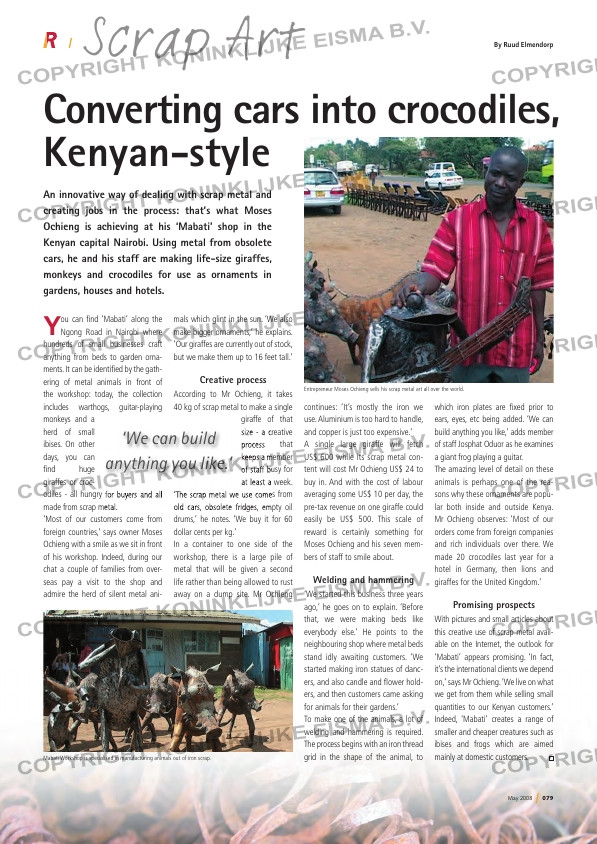Page 79 from: May 2008

May 2008 May 2008 079
By Ruud Elmendorp
You can fi nd ‘Mabati’ along the Ngong Road in Nairobi where
hundreds of small businesses craft
anything from beds to garden orna-
ments. It can be identifi ed by the gath-
ering of metal animals in front of
the workshop: today, the collection
includes warthogs, guitar-playing
monkeys and a
herd of small
ibises. On other
days, you can
fi nd huge
giraffes or croc-
odiles – all hungry for buyers and all
made from scrap metal.
‘Most of our customers come from
foreign countries,’ says owner Moses
Ochieng with a smile as we sit in front
of his workshop. Indeed, during our
chat a couple of families from over-
seas pay a visit to the shop and
admire the herd of silent metal ani-
Converting cars into crocodiles,
Kenyan-style
mals which glint in the sun. ‘We also
make bigger ornaments,’ he explains.
‘Our giraffes are currently out of stock,
but we make them up to 16 feet tall.’
Creative process
According to Mr Ochieng, it takes
40 kg of scrap metal to make a single
giraffe of that
size – a creative
process that
keeps a member
of staff busy for
at least a week.
‘The scrap metal we use comes from
old cars, obsolete fridges, empty oil
drums,’ he notes. ‘We buy it for 60
dollar cents per kg.’
In a container to one side of the
workshop, there is a large pile of
metal that will be given a second
life rather than being allowed to rust
away on a dump site. Mr Ochieng
continues: ‘It’s mostly the iron we
use. Aluminium is too hard to handle,
and copper is just too expensive.’
A single large giraffe will fetch
US$ 600 while its scrap metal con-
tent will cost Mr Ochieng US$ 24 to
buy in. And with the cost of labour
averaging some US$ 10 per day, the
pre-tax revenue on one giraffe could
easily be US$ 500. This scale of
reward is certainly something for
Moses Ochieng and his seven mem-
bers of staff to smile about.
Welding and hammering
‘We started this business three years
ago,’ he goes on to explain. ‘Before
that, we were making beds like
everybody else.’ He points to the
neighbouring shop where metal beds
stand idly awaiting customers. ‘We
started making iron statues of danc-
ers, and also candle and fl ower hold-
ers, and then customers came asking
for animals for their gardens.’
To make one of the animals, a lot of
welding and hammering is required.
The process begins with an iron thread
grid in the shape of the animal, to
which iron plates are fi xed prior to
ears, eyes, etc being added. ‘We can
build anything you like,’ adds member
of staff Josphat Oduor as he examines
a giant frog playing a guitar.
The amazing level of detail on these
animals is perhaps one of the rea-
sons why these ornaments are popu-
lar both inside and outside Kenya.
Mr Ochieng observes: ‘Most of our
orders come from foreign companies
and rich individuals over there. We
made 20 crocodiles last year for a
hotel in Germany, then lions and
giraffes for the United Kingdom.’
Promising prospects
With pictures and small articles about
this creative use of scrap metal avail-
able on the Internet, the outlook for
‘Mabati’ appears promising. ‘In fact,
it’s the international clients we depend
on,’ says Mr Ochieng. ‘We live on what
we get from them while selling small
quantities to our Kenyan customers.’
Indeed, ‘Mabati’ creates a range of
smaller and cheaper creatures such as
ibises and frogs which are aimed
mainly at domestic customers.
‘We can build
anything you like.’
An innovative way of dealing with scrap metal and
creating jobs in the process: that’s what Moses
Ochieng is achieving at his ‘Mabati’ shop in the
Kenyan capital Nairobi. Using metal from obsolete
cars, he and his staff are making life-size giraffes,
monkeys and crocodiles for use as ornaments in
gardens, houses and hotels.
Entrepreneur Moses Ochieng sells his scrap metal art all over the world.
Mabati Workshop is specialised in manufacturing animals out of iron scrap.
Scrap Art
RI_004 Scrap ART-Africa.indd 79 14-05-2008 13:45:50



